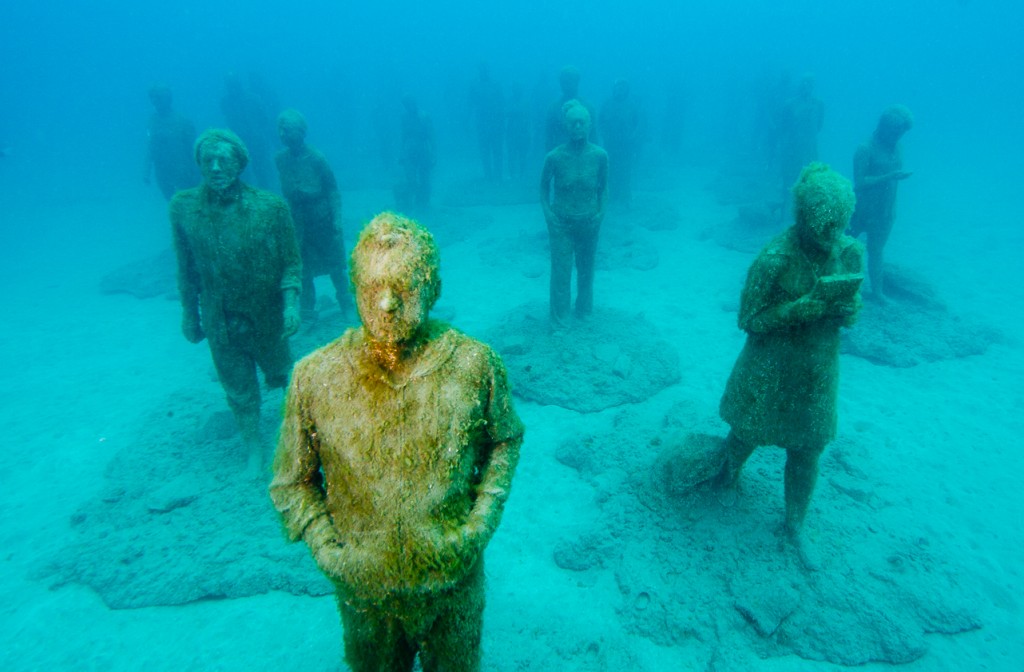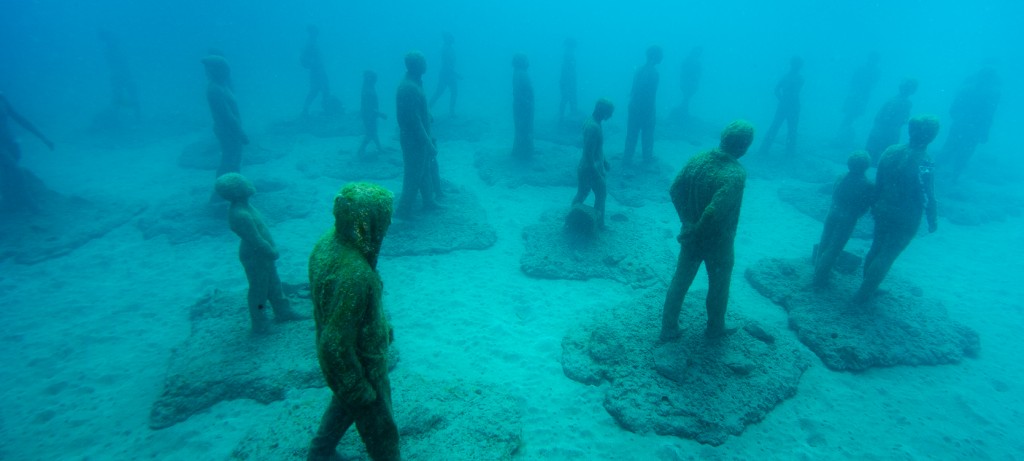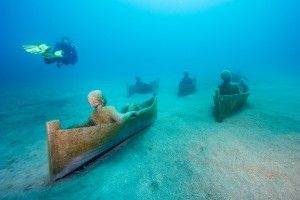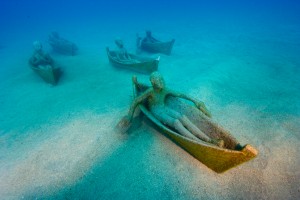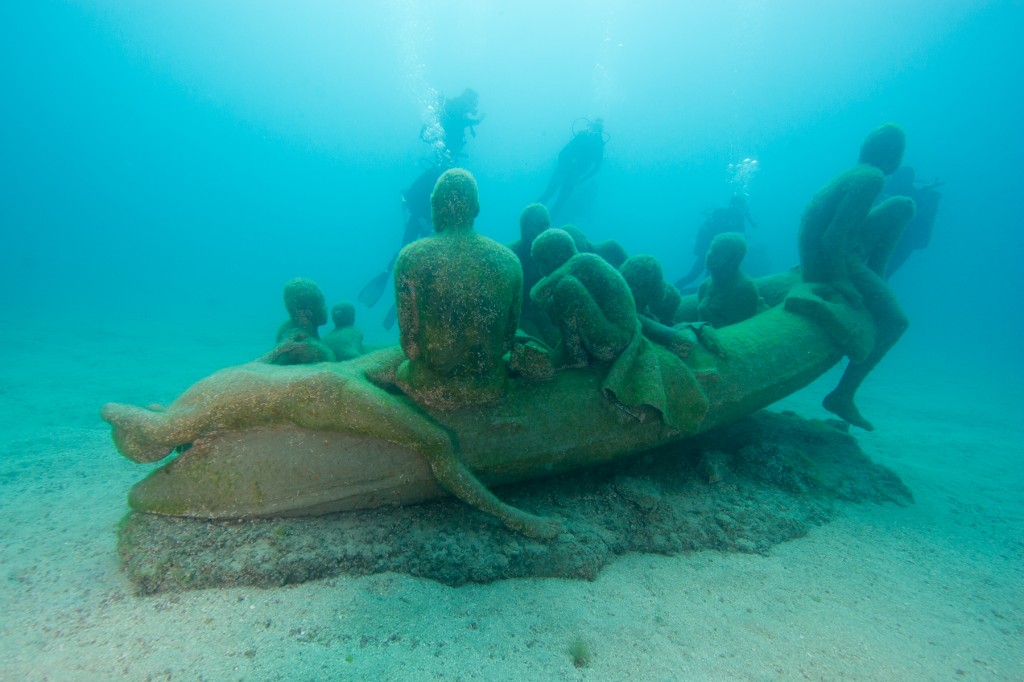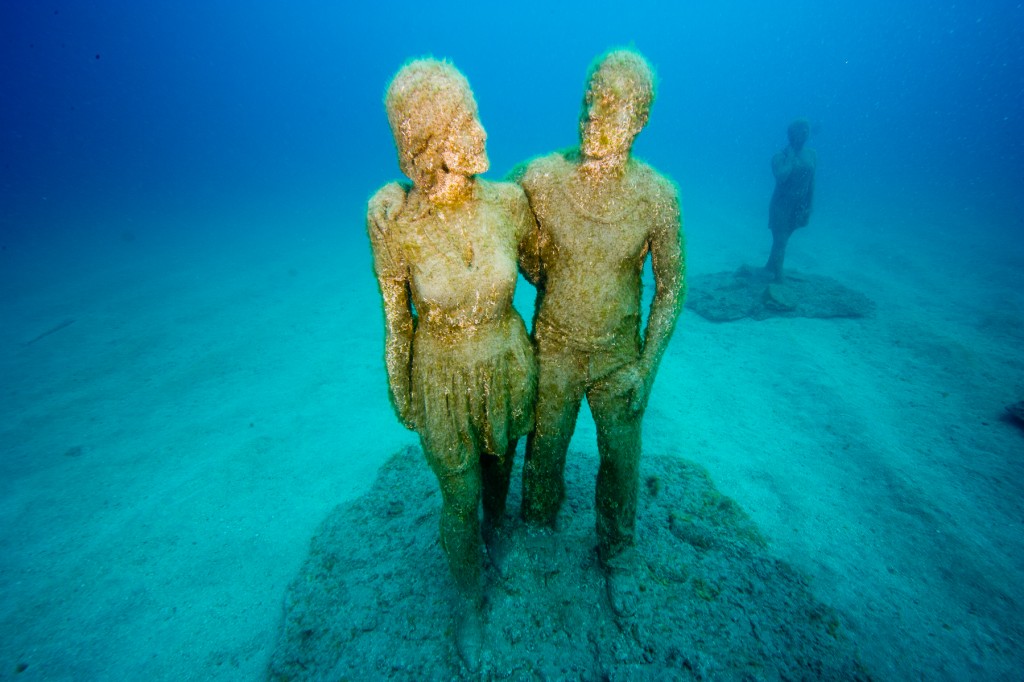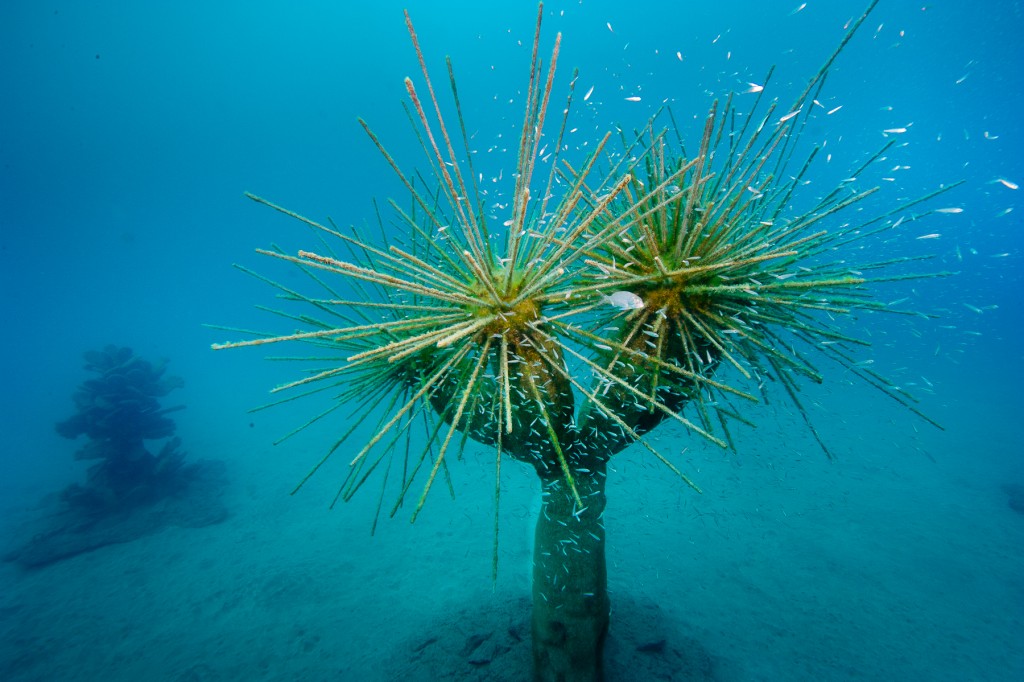News
Zombies vs Aliens: Exploring Europe’s First Underwater Museum
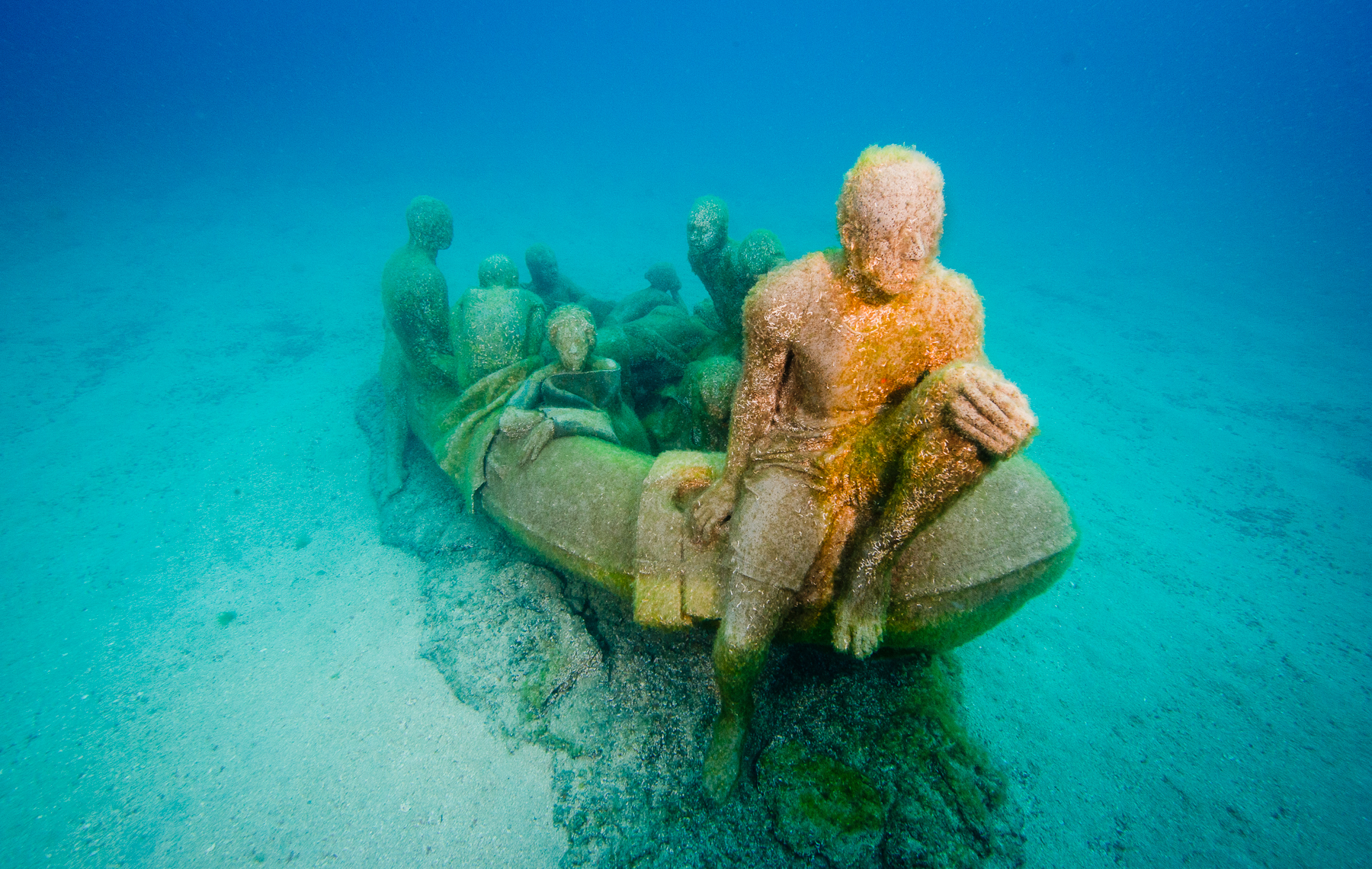
They were lined up like a mini army, an eerie group of the walking dead; zombies from another world. Like some weird catastrophic event – something from a B movie – a whole population on the march, frozen solid in stone and drowned underwater!
But although eerie and zombie like, the statues in front of us were beautiful too, each one uniquely different. A man in a hooded top, a fisherman in a waistcoat and cap, a barefooted lady reading a book, a mother and her young child, and a child on her own gazing up towards the surface. What seemed weird is that these statues looked more at home than we did. They seemed alive and at home where they stood. It was us who were invading their world, breathing air from our tanks and creating streams of bubbles; we were the aliens.
As our guide took us on our tour through Europe’s first underwater museum I was excited about what we’d see next. The first exhibit we were shown was a couple taking a selfie of themselves! Then it was on to a group of traditional dugout canoes manned by young boys. It represented a scene once common on Lanzarote’s shores where boys would paddle out to sea to race each other and to fish.
Our next exhibit was even more topical and relevant. “The Raft of Lampedusa”, a tribute to the refugee crisis and depicting a scene throughout the Mediterranean, that of a small boat packed with whole families including young children risking their lives as they flee from war and persecution to find a safe country to escape too and start a new life all over again. All these exhibits were brilliant and thought provoking in their own right, but the group of statues we were hovering over was the most impressive to me.
As the sun filtered down through the milky somewhat chilly water, they were very evocative, and perhaps the reason they seemed so eerie was down to the less than perfect underwater visibility. We could just see the surface some 15 metres above us, but horizontal visibility was even less and variable and wasn’t helped by the vertical swimming positions of some of the divers in our group.
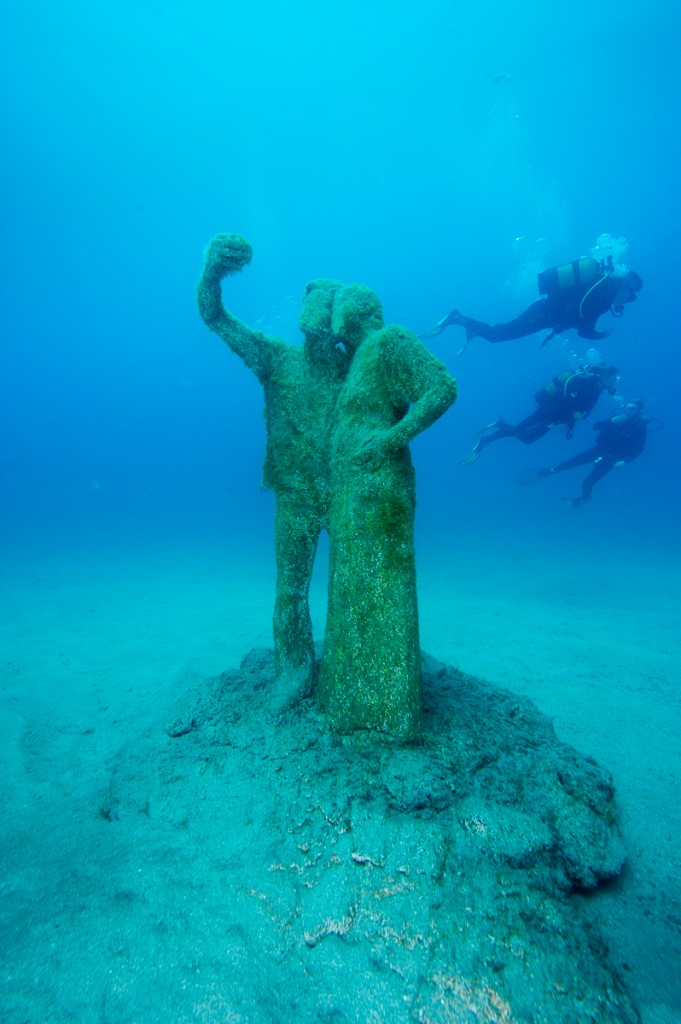 Arthur and I had been diving all week with Safari Diving out of Puerto del Carmen and had been recommended to book our Museum dive with The Dive College. Situated on the south west end of Lanzarote, there are a limited number of licensed dive centres with permits to take divers to the Museum. Each diver must pay a 7 euro entrance fee in addition to the cost of the dive, which tends to cost a little more than a regular dive on the island. Being a shallow dive it’s suitable for divers of all skill levels.
Arthur and I had been diving all week with Safari Diving out of Puerto del Carmen and had been recommended to book our Museum dive with The Dive College. Situated on the south west end of Lanzarote, there are a limited number of licensed dive centres with permits to take divers to the Museum. Each diver must pay a 7 euro entrance fee in addition to the cost of the dive, which tends to cost a little more than a regular dive on the island. Being a shallow dive it’s suitable for divers of all skill levels.
The museum has been designed and created by British artist Jason deCaires Taylor, who has also created similar amazing projects in Mexico, Grenada, and the Bahamas. The sculpture park in Grenada, which was the first of its kind in the world, has been listed as one of National Geographic’s Top 25 Wonders of the World; while most recently, “Ocean Atlas”, Taylor’s Bahamas creation, is the largest single underwater sculpture in the world, measuring 5 meters high and weighing over 60 tons.
Taylor’s statues are made up of a mixture of ingredients including wire and concrete, and are situated on sandy bottoms waiting to be transformed into completely new ecosystems, breathing rich new life into an area of low diversity.
The Atlantic Museum is best viewed as it is now by scuba diving, but soon areas will be created at shallower depths so snorkellers can easily swim down and enjoy the sculptures. As the museum grows and takes shape, a variety of very ambitious and exciting pieces will be added, including a giant mirror to create the illusion of a ‘pool’ in the sea, a large wall to create the walled garden, and an underwater fountain complete with actual lighting as its centrepiece.
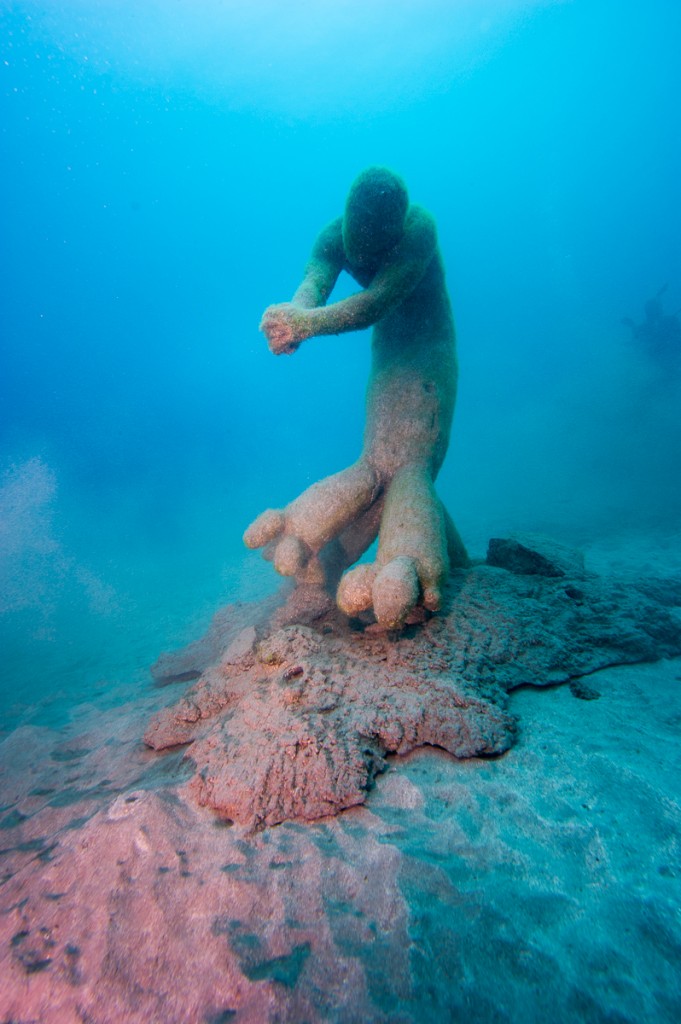 As we left the amazing statues of men, women and children, we followed our guide into what we were told in our pre-dive briefing will be the amazing garden area. In this spot there were already a number of fascinating statues. Half human, half plant, we swam over to a series of giant cacti. Some had human heads, some didn’t. One was clasping its hands with its arms stretched out – like a gardener tending to his crops – his feet forming part of a cactus.
As we left the amazing statues of men, women and children, we followed our guide into what we were told in our pre-dive briefing will be the amazing garden area. In this spot there were already a number of fascinating statues. Half human, half plant, we swam over to a series of giant cacti. Some had human heads, some didn’t. One was clasping its hands with its arms stretched out – like a gardener tending to his crops – his feet forming part of a cactus.
The Atlantic Museum project is massive. Originally 500 statues were planned at a cost of 700,000 euros of public funding. There was some controversy regarding the cost, and perhaps due to complaints things have been held up, as to date only 50-odd statues have been sunk. Due to statues only being permitted to be sunk in the winter season, no more are planned till later this year; but when it is finally completed, Lanzarote’s Underwater Museum will be fabulous and a real boost for tourism on the island (especially for Playa Blanca).
We were at the end of our tour and had reached what was undoubtedly my favourite piece. I’m not sure if it’s actually called the Tree of Life, but that’s what I would have called it. An artificial tree reaching up to the sky, it was home to hundreds of tiny fish taking shelter within its branches, feeding on the algae already beginning to cover it. Like tiny little lights, the fish reflected and bounced light all around the tree, making it look like it was being illuminated by loads of tiny fairy lights blinking off and on as the fish turn one way and the next. A lone predator watched them, waiting to pounce; it must have swum by and chanced upon this oasis in the desert.
Taylor’s pioneering projects have become hugely successful in terms of marine conservation, stimulating people to engage and become aware of the need to protect our fragile marine world. His creations are works of art that grow and change as the marine world shapes them, colours them and adds to their beauty. It will be interesting to see when his Atlantic Museum is finally finished – and where Taylor’s next project will take him.
Read Gavin’s article about diving other parts of Lanzarote here.
All of Gavin’s diving was arranged by Safari Diving Lanzarote.
News
Book Review: Fire on Monroe Bravo by Fred Lockwood

Fire on Monroe Bravo is the latest book in the Jack Collier series by Fred Lockwood. Our story begins with our lead characters, Jack and Sandro, owners of Marine Salvage & Investigation Company, arriving on the Monroe Bravo Oil & Gas Platform in the North Sea. Having secured a contract for their vessel the MV Stavanger to act as support ship to the platform for TransGlobal Oil, our protagonists are on a celebratory visit.
However almost as soon as they arrive a series of explosions rock the platform, causing huge damage, loss of life and the very real danger of a massive human, ecological and financial disaster.

As the danger mounts for both our heroes and the surviving workers, Jack and Sandro will have to escape the inferno, all while trying to save the platform and the men still trapped unable to help themselves.
The disaster sets the scene for the unfolding story lines following the fate of the platform and our main characters, the police investigation into a suspected terrorist act and the actions of TransGlobal Oil as they attempt to navigate the pubic outcry and financial repercussions.
In his eighth book, Fire on Monroe Bravo, Fred Lockwood delivers an explosive thriller, with plenty of above and in-water drama, and our heroes fighting for survival, what more can you ask for?
We thoroughly recommend this read and look forward to the next in the series. For more information about his book series, you can check out the reviews of his previous books here on Scubaverse.
- Title: Fire On Monroe Bravo
- Author: Fred Lockwood
- ISBN: 979-8325324536
Available in a paperback version and for Kindle from Amazon and book stores.
Blogs
Alonissos: The complete diving destination (Part 1)

In June we were incredibly fortunate to be invited to dive in Alonissos, a small Greek Island in the Sporades island chain located in the North Aegean Sea. While I have long been a big fan of the Greek Islands as a great holiday destination, I had not had the opportunity to do any diving on previous visits and Mike and I were extremely excited to see what Alonissos had to offer both above and below the surface!

The Sporades are easily accessible via the airport in Skiathos (the first island in the chain), which is served by Jet2 flights from all major UK airports from May through October. Numerous ferries and charter boats make island hopping from Skiathos Town a breeze. After an hour boat ride, the picturesque port of Patitiri was a wonderful introduction to Alonissos, where we were met by our gracious hosts Kostas of Albedo Travel and Dias of Alonissos Triton Dive Center. Mike and I were delighted to be staying at the Paradise Hotel, aptly named for its stunning views over the sea and great location for walking to the waterfront.

Alonissos is beautifully situated in the National Marine Park of Alonissos and the Northern Sporades, the largest marine protected area in Europe. The surrounding seas offer fabulous marine life, including incredibly rare species such as the Mediterranean monk seal. They boast deep walls covered in gorgonians and sponges, stunning topography with caverns, swimthroughs and pinnacles, and the first accessible ancient shipwreck from 500BC!

In locations where historical sites have been reported, the waters are largely restricted, but with collaboration between government, underwater archeologists and dive centres, incredible underwater museums are being created for a truly unique diving experience. Alonissos is home to the first of these, the Ancient Shipwreck of Peristera Accessible Underwater Archeological Site. The chance to dive into history (along with reports of healthy reef life and amazing underwater topography) meant Mike and I were keen to get in the water.

Our introduction to the diving around Alonissos was at the Agios Georgios Pinnacles, in the channel between Alonissos and Skopelos. This fantastic site was named “The Chimney,’ and proved to have a huge amount to see. We got to a decent depth here (over 25m), and marvelled at a colourful reef wall with a wonderful swim through whose rocky walls were absolutely covered with life. As well as brilliant topography there was no shortage of macro life here. We saw numerous nudibranchs, five different species in total. The second dive at Mourtias reef nearby was a shallower dive along a nice wall with lots of crevices. Several moray eels and grouper called this site home. We enjoyed looking in the crevices for lobster and smaller benthic life, such as cup corals and tunicates.

Our itinerary allowed us two dives a day with afternoons left to explore the island with our hire car and evenings to enjoy the famous Greek hospitality. This proved to be a lovely mix of in-water and land based diversions.

The next days diving to the Gorgonian Gardens and Triton’s Cave was to be even better! These two stunning sites are nothing short of fabulous. The Gorgonian Gardens was a deep wall near to the Agios Georgios islands. The ever-present currents in this deep channel meant that the sea life was amazing … the namesake Gorgonian sea fans dotted the wall at a depth of 30 to 50 meters, getting ever larger the deeper we went. Above 30m was by no means less beautiful, with sponges, corals, scorpionfish, moray eels and some rare and colourful nudibranchs.

The second shallower dive of the day was to Triton’s Cave or the Cavern of Skopelos, on the east side of that island. The spectacular rock formations had wild striations both above and below the water making a truly epic topography. The cavern entrance was at 14m, and big enough for a buddy pair, winding up to 6m and passing two beautiful windows out into the blue. Emerging from the cavern, the light at the shallower depths and the incredible rock formations made for a fantastic gentle swimming safety stop and we all surfaced by the boat with massive grins.

Check out our next blog :Alonissos: The complete diving destination (Part 2)” to hear about our amazing dive on the 2500 year old Peristera Wreck!
Thanks to:
Alonissos Triton Dive Center https://bestdivingingreece.com/
Albedo Travel https://alonissosholidays.com/activities/
Paradise Hotel https://paradise-hotel.gr/
Alonissos Municipality https://alonissos.gr/en/
-

 Blogs2 months ago
Blogs2 months agoDiving With… Nico, Ocean Earth Travels, Indonesia
-

 News1 month ago
News1 month agoMurex Bangka Announce New Oceanfront Cottages & Beachfront Dining
-

 Blogs2 months ago
Blogs2 months agoA new idea in freediving from RAID
-

 Marine Life & Conservation1 month ago
Marine Life & Conservation1 month agoIceland issue millionaire whale hunter a licence to murder 128 vulnerable fin whales
-

 Marine Life & Conservation2 months ago
Marine Life & Conservation2 months agoThe Shark Trust Great Shark Snapshot is back
-

 News3 months ago
News3 months agoCharting New Waters; NovoScuba Goes Global with the Launch of their Revolutionary Dive Training Agency!
-

 Gear News1 month ago
Gear News1 month agoNew Suunto Ocean – a dive computer and GPS sports watch in one for adventures below and above the surface
-

 Marine Life & Conservation Blogs2 months ago
Marine Life & Conservation Blogs2 months agoBook Review: Plankton


